|
Thursday, July 9
- Tomato Florentine
- *Pork BBQ sandwich
- Kielbasa & sauerkraut
- Chicken marsala
- Smoked turkey melt
- Assorted sliced pizza
- SW chicken salad w/roasted corn salsa
*Carb restricted alternative
Wilson Hall Cafe Menu |
|
Thursday, July 9
Dinner
- Closed
Wednesday, July 15
Lunch
- Maple bourbon glazed salmon
- Roasted potatoes
- Baby carrots w/dill
- Caramel apple shortcake
Chez Leon Menu
Call x3524 to make your reservation.
|
|
|
University of Florida
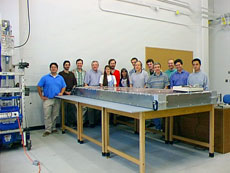 |
| University of Florida physicists at the University's physics department experimental hall stand
next to a test-ready CMS endcap muon cathode strip chamber. |
NAME:
University of Florida
HOME TOWN:
Gainesville, Florida
MASCOT:
Gator
SCHOOL COLORS:
Orange and blue
PARTICLE PHYSICS COLLABORATIONS:
CDF, CMS, CLEO, MiniBooNE, MINERνA, CDMS, Solid Xenon, LIGO, LISA and ADMX.
EXPERIMENTS AT FERMILAB:
CDF, MiniBooNE and MINERνA.
SCIENTISTS AND STUDENTS AT FERMILAB:
Since 1996, we have had 15 scientists and 12 students working on experiments at Fermilab.
COLLABORATING AT FERMILAB SINCE:
1996
MAJOR CONTRIBUTIONS TO FERMILAB EXPERIMENTS:
Construction and operation of a novel Cherenkov luminosity monitor detector for CDF, construction and operation of cathode strip chambers for the CMS endcap muon detectors, development of the CMS endcap muon L1 trigger, operation of a CMS Tier-2 computing site and development of strong high-performing computing facilities. Design and construction of a Xenon crystallization chamber for the Solid Xe experiment.
Spokesperson in CDF, leadership roles in CDF's exotics, top and quantum chromodynamics groups and CMS's muon systems, trigger and Higgs group. Played key roles in CMS detector commissioning. Participate in CMS management boards. Helped lead MiniBooNE's anti-neutrino mode analysis and MINERvA's project management.
PARTICLE PHYSICS RESEARCH FOCUS:
Top quark physics, QCD, Higgs and searches for new physics in CDF and CMS. Searching for new charmed baryon states at CLEO and gravitational waves searches with LIGO and LISA. Dark matter searches including axions and WIMPs.
WHAT SETS PARTICLE PHYSICS AT UNIVERSITY OF FLORIDA APART?
The University of Florida has a very large high-energy physics experimental program. The group has broad experience in detector construction, computing, physics analysis and leadership positions in the experiments we participate on. We also have theorists that we collaborate closely with and some theorists who have joined some of the experiments we work on. All of these projects are part of the University of Florida's Institute of High Energy Physics and Astrophysics (IHEPA).
FUNDING AGENCY:
Department of Energy and National Science Foundation
FAVORITE NATIONAL LABORATORY:
Fermilab

View all University profiles
|
New employees
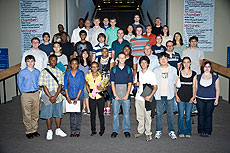
New employees, including a group of TARGET program summer students, who began work on Monday, June 15. Bottom row from left: Luis Abrego, D'Angelo Cox, Tonisha Taylor, Elissia Franklin, Joshua Hall, Alejandro Fuentes, Sungwoo Youn, Kelly Swanson and Jessica Rippel. Second row from left: Keegan Freiburger, Andrew Cao, Piali Yang, Victoria Smith Ellison, Camilla Brewer, Tom Prosapio, Benedetto Di Ruzza and Branko Popovic. Third row from left: Fernando Olayo, Jeremy Williams, Adil Tobaa, Matt Bajzek, Alexey Naumov, Anatoli Malcarivich, Virginia Melanson and Genevieve DiMarco. Fourth row from left: Jeremey Johnson, Jerrold Mason, Evgeny Toropov, Alexander Vostrikov, Jo-Anne Butt, Kathryn Newton and Melissa Winchell. Top row from left: James Browne, Patrick Swanson, Chris Ozarka and Jeff Van Harlingen.
|
First information on FY2010 House DOE Appropriations bill
From AIP FYI, July 8, 2009
The House Appropriations Committee met at 7 p.m. last night to consider two FY 2010 funding bills, and did not complete its work until after midnight. The committee approved the Financial Services Bill, and, of more direct interest to the physics community, the closely-watched Energy and Water Development Appropriations Bill which funds the Department of Energy.
House appropriators released a four-page summary of the bill's provisions. The committee report, with detailed budget and policy recommendations, is now being printed and will be issued in the next few days.
Here is what is known about the bill approved early this morning:
The bill provides less money than requested by the Obama Administration: $33.3 billion as compared to the requested $34.4 billion.
Total spending would increase less than 1.0 percent over the current year.
The Administration requested an increase of $184.1 million or 3.9 percent, from $4,757.6 million to $4,941.7 million, for the Office of Science. The House Appropriations Committee summary states that the bill provides an increase of $171 million, which is an increase of 3.6 percent. The statement notes: "This funding, in addition to the $4.8 billion appropriated in fiscal year 2008 and $1.6 billion in the Recovery Act, exceeds the goals in the America COMPETES Act."
Read more
|
|
|
"X" marks the spot
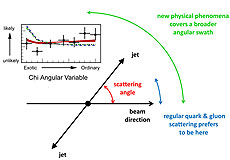
Ordinary quark and gluon scattering preferentially occurs at small angles measured from the beam direction. Scientists expect that many new physical phenomena will be produced more uniformly. The inset plot shows data (black points), standard theoretical predictions (red) and various new physics predictions (dashed lines). The data clearly favors ordinary physics. These particular collisions involve half the energy delivered by the Tevatron - an extraordinarily large collision energy. Scientists can use these plots to rule out new physical phenomena for energies several times higher than the Tevatron's maximum beam energy.
Picture this. A muddy man, patch on one eye and a cutlass on his hip, walks alone with a shovel over his shoulder toward a ship flying a black and white flag. His most precious possession lies hidden deep in a pocket, a parchment with a large "X" marked on it to show the location of his treasure. DZero scientists think that "X" could also point the way to a trove of new physics.
DZero scientists have just completed an analysis in which χ, the Greek letter "chi," stands in for the "X" and plays a prominent role. Chi is a measure of the parton scattering angle. Partons are the particles (quarks and gluons) found inside protons and it is in the measurement of chi that DZero scientists have found real treasure.
The most common type of collisions observed at the Tevatron are ones in which partons from the beam particles are scattered. These quarks and gluons then convert into many particles, looking a bit like a shotgun blast. These blasts are called jets. They play a leading role in many physics analyses. The problem is that any detector will slightly mismeasure the energy of the particles in the jet, making jet measurements a tricky business indeed.
Detectors can also mismeasure the direction in which a jet is travelling, but this mismeasurement is much smaller. Thus if one could study the angle between the jet direction and the beam direction and interpret that measurement correctly, one could draw very precise conclusions about the underlying physical processes. DZero scientists have done just that.
The scientists exploited the fact that ordinary quark and gluon scattering preferentially occurs at small angles compared to the beam. In contrast, for many exotic new physics ideas, the quarks scatter more uniformly. Thus the signature of new physical processes would be an excess of jets produced at angles near 90 degrees from the beam. By studying the jet angular distribution, physicists were able to set the strictest limits to date on the size of possible objects inside quarks and the size of extra-spatial dimensions beyond our familiar three. This measurement is pure gold.
It's not only for pirates that "X" marks the spot for treasure.
-- Don Lincoln
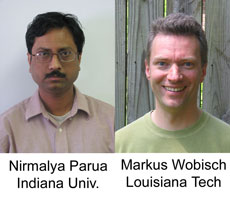
Nirmalya Parua and Markus Wobisch were both instrumental in making this very precise measurement.
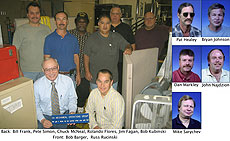
The DZero mechanical crew makes many important contributions to the DZero experiment through operation and maintenance of the detector and building infrastructure. During this shutdown period, the mechanical crew members are especially busy reconfiguring the detector to facilitate the repairs and improvements scientists are currently making.
|
|